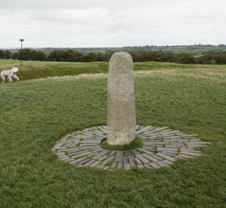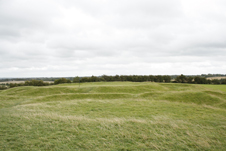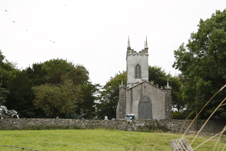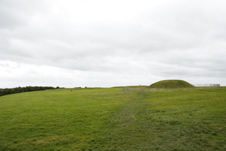
 |
 |
 |
 |
a |
 |
|
HILL OF TARA
|
|
Cormac and his warriors leave Tara and travel to Clonard. They will set up camp outside Clonard this night. The High King of Ireland, Cormac Mac Airt, led his army from the Hill of Tara into Munster to collect taxes by force. He set up camp at Droim Dámhgháire / Knocklong Hill. They travel 210kms in 5 days and 5 nights, arriving on the Hill of Knocklong on the morning of the sixth day. They lose a week enroute due to Druid mischief. It had been prophetised by Aonghus that a disastrous cattle disease would occur during the reign of Cormac Mac Airt. The
year of the Cattle disease Cormac collected
all his taxes and tributes due from the five
provinces of Ireland. This amounted to almost
900 cows. He distributed the tribute generously. Cormac
decided to ask the men of Munster for more tribute
and taxes. Fiachra at Cnoc Rafann,
close to Cahir and the men of
Munster assembled and decided they would not
pay the tribute. Cormac collected an army from three provinces and prepared to invade Munster. Cormac
called his druids to examine the omens for the
expedition. Cormac was delighted and set out on his expedition.
TARA Hill (507 feet) in Co. Meath, 6 miles SE of Navan,
residence of the High Kings of Ireland According to the Lebor Gabála (The Book of Invasions), the Milesians named the site Temair after Éremón's queen, Téa. Tara is one of the best known sites in the world and its name is evocative of the Celtic past. On a grey morning in early September with the mounds of Tara shrouded in fog, it is easy to imagine the warriors of Cormac Mac Airt training in the surrounding fields, as athletes trained and prepared on Olympus in Ancient Greece. The glory of Tara is that it is saturated with the past, whether reality or fiction. There are over thirty visible monuments on the Hill of Tara relating to burial and ritual, spanning 4000 years, from 3500BC to the 6-7th Century AD
Features of the Tara site include: ‘Banqueting Hall’ Cormac's House Fort/Rath of the Kings Rath of the Synods. Lia Fáil (stone of destiny) Mound of the Hostages Ráth Gráinne Ráth Lóegaire Ráth Maeve Royal Seat Sloping Trenches TARA OF THE KINGS Department of the Environment - National Monuments - Hill of Tara Heritage Ireland Information on the Hill of Tara Meath Tourism Information on the Hill of Tara National Museum Exhibition-Rites of Passage at Tara |